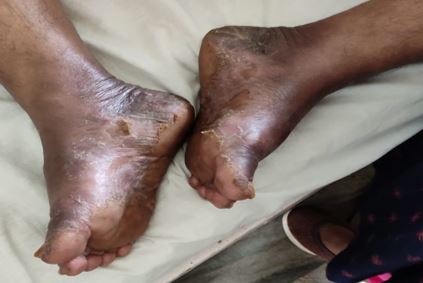Ayurvedic management of Vipadika - A Case Report
DOI:
https://doi.org/10.21760/jaims.9.8.37Keywords:
Vipadika, Kshudra Kustha, Palmoplantar Psoriasis, Shamana OushadhiAbstract
Vipadika, categorized as a type of Kshudra Kustha in Ayurveda, presents as a chronic dermatological condition primarily affecting the palms and soles, characterized by symptoms such as Pani-Pada Sphutana (fissures), Teevra Vedana (severe pain), Manda Kandu (itching), and Saraga Pidika (red patches). Vipadika can be correlated to Palmoplantar psoriasis, which is a prevalent chronic inflammatory skin disorder characterized by erythematous plaques affecting the palms and soles significantly impairing daily function and quality of life. Ayurvedic management of Vipadika emphasizes Shamana Oushadhis aimed at pacifying aggravated Doshas, alleviating manifestations of Vipadika. Integral to this approach are Nidana Parivarjana and Pathya Ahara-Vihara Sevana to prevent recurrence. In the present case, a male patient with complaints of dryness, itching, cracking, scaling, and hyperpigmentation of skin of bilateral feet and bleeding from cracks for the last 6 months came to Kayachikitsa OPD and was diagnosed and treated as Vipadika with the Shamana Oushadhis. The patient's condition demonstrated a substantial improvement, with a marked reduction in symptoms evident within 21 days, suggesting effective management of Vipadika through Ayurveda.
Downloads
References
Vagbhata. Astanga Hridayam of Srimadvagbhata, Nidanasthana Adhaya 14/23. Edited by Tripathi BB. Varanasi: Chaukhamba Sanskrit Pratishthan; 2013.
Yadavji Trikamji, editor. Sushruta Samhita of Sushruta, Nidanasthana; Kshudraroga Nidana Adhyaya: Chapter 13, Verse 29. 6th ed. Varanasi: Chowkambha Orientalia; 1997. p. 321.
Shrivastav P, Dasar D, Parwe S, Nisargandha M. Management of Vipadika (Palmoplantar Psoriasis) through Nitya Virechana and Shaman Chikitsa: A case report. J Indian Sys Med. 2023;18:563-76.
Basotra S. Evaluate the efficacy of Virechana Karma and Lepa in Vicharchika. Rajiv Gandhi University of Health Sciences; 2014.
Kimmel GW, Lebwohl M. Psoriasis: Overview and diagnosis. Evidence-Based Psoriasis. 2018 Jul;1–16.
Miceli A, Schmieder GJ. Palmoplantar psoriasis. Treasure Island (FL): StatPearls Publishing; 2022.
Dogra S, Yadav S. Psoriasis in India: Prevalence and pattern. Indian J Dermatol Venereol Leprol. 2010;76:595–601.
Khandpur S, Singhal V, Sharma VK. Palmoplantar involvement in psoriasis: A clinical study. Indian J Dermatol Venereol Leprol. 2011;77:625.
Charaka. Charaka Samhita (Chakrapani Hindi Vidyotini Commentary). Edited by Narayan Shastry. Varanasi: Chaukhamba Sanskrit Sansthan; 2012. p. 253.
Baliwag J, Barnes DH, Johnston A. Cytokines in psoriasis. Cytokine. 2015;73:342–50.
Kundra L, Verma P, Dharmarajan P, Bhatted SK. A case study on Ayurveda interventions in lipodermatosclerosis. J Indian Sys Med. 2020 Jul;8(3):217.
Deva S. A case study on the management of Kitibha Kushta (Psoriasis) with Virechana, Dhanyamla Dhara, and Takra Dhara. IJAM. 2023;13(1):185-90.
Lokhande S, Patil S, Parshurami S. Efficacy of Panchatikta Ghrit Guggul in the management of Mandal Kushtha with special reference to psoriasis. Int J Res Ayurveda Pharm. 2016;7:94-96.
Madduru MH, Jadar PG. A review on the probable mode of action of Gandhaka Rasayana - An Ayurvedic herbo-mineral formulation with multifaceted action. Int J Ayurveda Pharma Res. 2024;12(2):173-79.
Raghuwanshi B, Ade VN. Comparative study of Jeevantyadiyamaka Lepa and Vipadikahar Lepa in the management of Vipadika. Int J Ayurvedic Med. 2020;11(4):650-5.
Roy B. Clinical efficacy of Sarvanga Parisheka in Eka-Kushta w.s.r. to Psoriasis. Int Ayurvedic Med J [online]. 2023 [cited July 2023].















